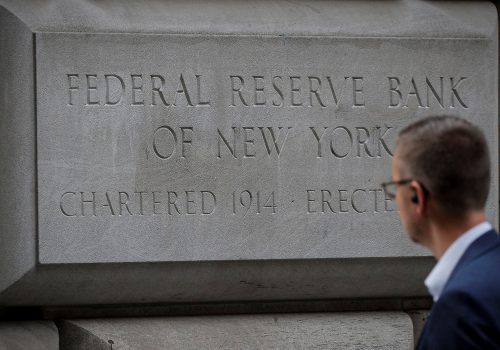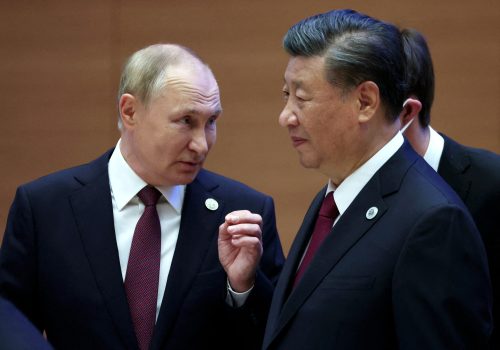Not so fast: The case for a new SWIFT
In the new Netflix hit series The Diplomat, a fictional UK prime minister accurately ticks through the ways Russian President Vladimir Putin has been punished for his invasion of Ukraine: “We sanctioned Russian debt, embargoed their oil, and banned them from SWIFT.” In the fifteen months since Russia’s full-scale invasion of Ukraine, the Society for Worldwide Interbank Financial Telecommunication (SWIFT) has gone from a Belgian cooperative assisting banks in messaging each other to a centerpiece of the West’s economic arsenal. The problem is few people—even those leveraging its power to hurt Russia—understand what SWIFT is. Fewer still see what it could be in the future.
SWIFT was founded in 1973 with 239 original members and over the years has grown to incorporate 11,696 banks sending more than 44 million messages around the world every day. But the core idea has stayed the same: Banks need a uniform and standard way to communicate with each other about transactions, and SWIFT is the answer. Every member gets a unique code—with details about country, location, and even bank branch. When a bank wants to transfer money to another bank, it simply enters the code through the SWIFT network, tells the other bank the amount, and then the actual money changes hands.
But here’s the rub—SWIFT is only a messaging service. It does not provide bank accounts or hold funds for banks in any capacity. The banks actually transfer the funds through a different entity. In order to send money across borders, individuals usually need to use a trusted network of banks, which settle transactions through a series of mutually held accounts. Think of SWIFT like a very elite Gmail, but once you tell your friend you want money, they have to switch over to Venmo to actually pay you. That’s why ‘banning’ a bank from SWIFT does not mean that the institution cannot get money from other banks. It just makes it more complicated and costly to do so.
In 2020, global businesses transferred approximately $23.5 trillion across borders—and it cost them over $120 billion to process the transactions. That’s like paying a tax the size of Morocco’s entire gross domestic product. Plus, these payments often take days to settle. It’s a lot of money for slow service, and that cost gets passed on to consumers.
How banks move money around the world
Interactive graphic by Sophia Busch, Alisha Chhangani, and Nancy Messieh.
What if SWIFT helped build something faster and cheaper? What if you could create a network that could combine both messaging and settlement and become a one-stop shop for international payments? That’s what China has been working on since 2016 with its Cross-Border Interbank Payments System, or CIPS, and most recently with its wholesale central bank digital currency (CBDC) experiment, the mBridge Project.
Both the CIPS and mBridge projects can be utilized for cross-border wholesale (meaning bank-to-bank) purposes. Importantly, the mBridge project is a cross-border CBDC initiative. The idea for both is that large sums of money could be sent between banks internationally, without using SWIFT for messaging or the dollar-based payments clearance hub, the Clearing House Interbank Payments System (CHIPS), for settlement. Already Hong Kong, the United Arab Emirates, and Thailand have partnered with the People’s Bank of China on the mBridge project, and in October 2022, they settled twenty-two million dollars across borders. This was the first successful test of cross-border bank-to-bank digital currency involving real money. As Atlantic Council research on CBDCs has shown, mBridge is just one of more than a dozen wholesale CBDC projects globally, many of which accelerated after Russia’s invasion of Ukraine and the Group of Seven (G7) sanctions response. Over time, if these systems are successful, they could create alternative financial transfer networks and provide a useful conduit for countries aiming to avoid the bite of Western sanctions.
SWIFT is not sitting idly by. The technology teams at its headquarters outside of Brussels are piloting their own cross-border CBDC system, partnering with major private banks and central banks including the Banque de France and the German Bundesbank. They are also experimenting with new, faster types of global transfers between banks. But transforming SWIFT from a messaging system to a new cross-border settlement system that can handle all types of assets (both traditional and digital) is going to take years and millions of dollars. Where to start?
The first step is for the board that governs SWIFT to give it the green light to innovate. As SWIFT members are eager to point out, they are a “private cooperative” and answer to their shareholders. But it’s not so simple. SWIFT is overseen by the National Bank of Belgium and the European Central Bank alongside the central banks of Italy, the Netherlands, Switzerland, Sweden, Canada, Japan, the United Kingdom, and the United States.
These countries have responsibility for providing SWIFT with strategic guidance and helping direct its technology planning. But so far no central bank has publicly come out in support of a major modernization effort. That’s a mistake.
It is understandable for Western central banks to feel sanguine about SWIFT’s current dominance. After all, the vast majority of global transactions currently touch SWIFT at some point. But look closer and you can see the ground shifting. Last month, Bangladesh agreed to pay a Russian company that is helping the country build a nuclear power plant in Rooppur. What’s interesting is how it is paid. Since Russian banks are largely banned from SWIFT, Bangladesh used a bank account at a Chinese bank that transferred yuan to Russia through CIPS.
Bangladesh is not alone. Transaction volume on CIPS has more than doubled since 2020, and the number of direct and indirect participants in its network has also increased. More and more of these transactions will develop outside of SWIFT, and governments will understand less and less of what’s happening. Part of the motivation is geopolitical, given the way the dollar and euro are being weaponized against Russia. But a large part of it is simply technological: There are faster and cheaper ways to exchange money between countries, and if SWIFT does not figure out how to do it, someone else will.
Even if it is somewhat late to the game, SWIFT has a massive incumbent advantage. With its network of more than eleven thousand banks, SWIFT can build on a system that the world already relies upon instead of creating something new from scratch. China and Russia have to build a rival from the ground up and that takes time. SWIFT’s network is familiar and trusted: Think of it like an individual customer—why switch to a whole new bank if my current one is going to offer all the same features? If there are disputes, or mistakes, they can be settled in European courts.
Plus, SWIFT has something no one else can offer. It is the gateway to interacting with banks in New York, London, Tokyo, Paris, and Frankfurt. The argument for the new SWIFT is simple: If you want to be interoperable with the dollar, the euro, the pound, and the yen—which together are used in more than 85 percent of global transactions—this is the place to do it. If the G7 works in tandem to set technical and regulatory rules of the road for this new network it will, over time, become the de facto global standard, just like the original SWIFT of the 1970s.
The new SWIFT will have to do multiple things at once: communicate and settle between thousands of banks all over the world, find a way to transfer traditional commercial bank money as well as money on a blockchain, and do it all before a network of regional systems springs up to challenge its effectiveness and increase the fragmentation of money and finance.
Doing this right requires a massive investment in innovation from the Western banks that guide SWIFT. The United States is going to have to spend money and bring its own technological solutions to the table. There are major risks involved with faster settlements, including the need for adequate liquidity to complete the transaction, and it will require new regulations to ensure the system is trusted and secure. The recent Silicon Valley Bank crisis, accelerated by a social media–fueled bank run, should provide a lesson on the perils of moving money quickly in the digital age. And while SWIFT rebuilds, it will need to maintain its current operations. Remodeling a house while living in it is a tricky proposition.
But the bigger risk is doing nothing. This year SWIFT will turn fifty. For decades, SWIFT was the pace setter in the race for the future of money. Its technology connected the world’s financial institutions and helped ensure a system with Western protections on rule of law, privacy, and anti-money laundering provisions became the global standard. But all that is changing. If the United States and its allies want to create and promote the technological standard for the decade ahead while ensuring the effectiveness of sanctions, it’s time to start moving, well, more swiftly.
Josh Lipsky is the senior director of the Atlantic Council’s GeoEconomics Center and a former IMF advisor.
Ananya Kumar is the associate director of digital currencies at the Atlantic Council’s GeoEconomics Center.
Further reading
Thu, Dec 15, 2022
It’s official: The United States is developing a bank-to-bank digital currency
New Atlanticist By Josh Lipsky, Ananya Kumar
The New York Federal Reserve’s latest project shows the United States making its presence felt in the digital-currency race.
Wed, May 10, 2023
What is the G7 still exporting to Russia?
Econographics By Niels Graham
One year into the Russia's invasion G7 nations continue to export nearly $5B a month to Moscow. A new proposal by the US at the G7 could greatly reduce this.
Wed, Feb 22, 2023
Russia and China have been teaming up to reduce reliance on the dollar. Here’s how it’s going.
New Atlanticist By Maia Nikoladze, Mrugank Bhusari
Squeezed by sanctions, Russia has turned to Chinese yuan and gold, but both introduced new vulnerabilities and inconveniences.
Image: The logo of Swift, the Society for Worldwide Interbank Financial Telecommunication.


